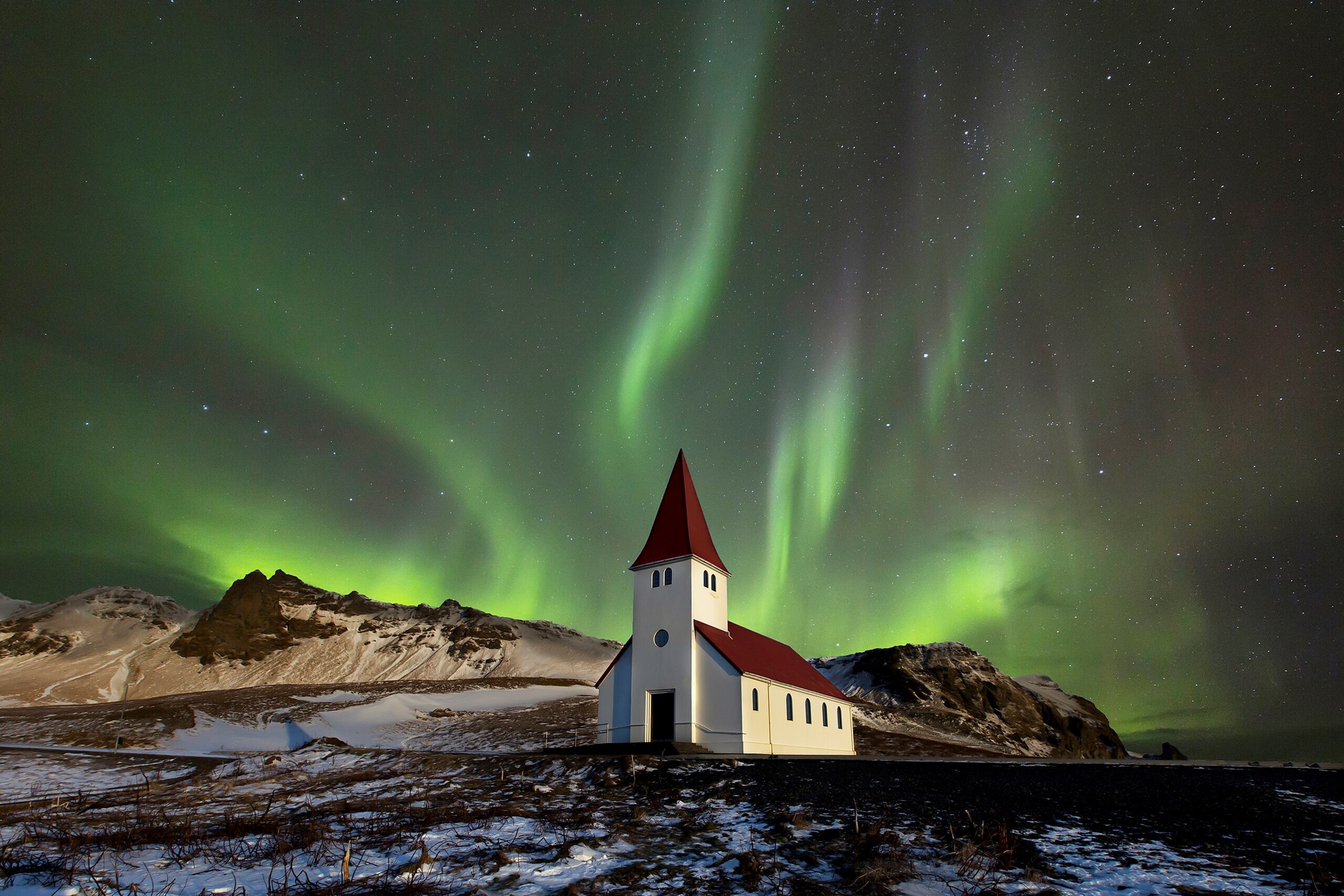
Credit: AstroAnthony, CC BY 4.0, via Wikimedia Commons
Every 11 years, the Sun cycles from solar minimum to solar maximum, as we discussed in a prior EarthDate. And we’ve just entered another solar maximum, where the Sun emits many more charged particles in a faster, stronger solar wind moving toward Earth.
You might experience it in disrupted GPS or cellular signals. But you can see it in the night sky. Specifically, in the aurora borealis, the famous northern lights.
You may remember, also from a prior episode, that Earth’s magnetic field shields us from the charged particles in the solar wind, allowing life on Earth.
Some particles still get through but are directed by the magnetic field around Earth toward its magnetic poles.
These particles excite atoms in the atmosphere, which emit light. Oxygen emits mostly green light, and nitrogen red. They blend together in unusual ways to create many colors including blue, purple and pink.
With stronger solar winds, more charged particles will get through, meaning brighter auroras that will be more visible, even at lower latitudes like the Midwest United States.
But they’ll still be the most visible within 30 degrees of the magnetic poles, when the pole is farthest from the Sun, around midnight. And particularly around the spring and autumn equinox.
So for your best shot at a spectacular nighttime light show, head to the Arctic Circle in mid-September. Maybe I’ll see you there.
Background
Synopsis: Auroras are beautiful dancing curtains of colorful light that are typically visible at high latitudes, encircling Earth’s north and south poles. Although auroras occur in Earth’s thermosphere, they are driven by solar activity. Charged particles in the solar wind excite atoms and molecules high in Earth’s atmosphere, causing them to emit photons that illuminate the sky. As solar activity increases, auroras expand southward. These eerie light shows have intrigued humans for millennia. They have now been discovered on other planets in our solar system.
- Earth’s “northern” or “southern” lights appear as flowing curtains, ribbons, rays, spirals or flickers of light that may cover part or all of the night sky.
- Aurora borealis is the name of the northern phenomenon, while aurora australis is the name for the southern lights.
- In Greek and Roman mythology, Aurora is the dawn, sister of the Sun and the Moon, who rides her chariot through the night skies to alert her siblings to the break of day.
- In Latin, borealis means northern, while australis means southern.
- Humans have been frightened, fascinated, and inspired by auroras for centuries.
- Dragon legends in China and Europe are thought to have originated from auroras’ serpentine motions.
- Vikings believed the lights were manifestations of Norse gods leading the souls of slain earthly warriors across a pulsing bridge of light to Valhalla.
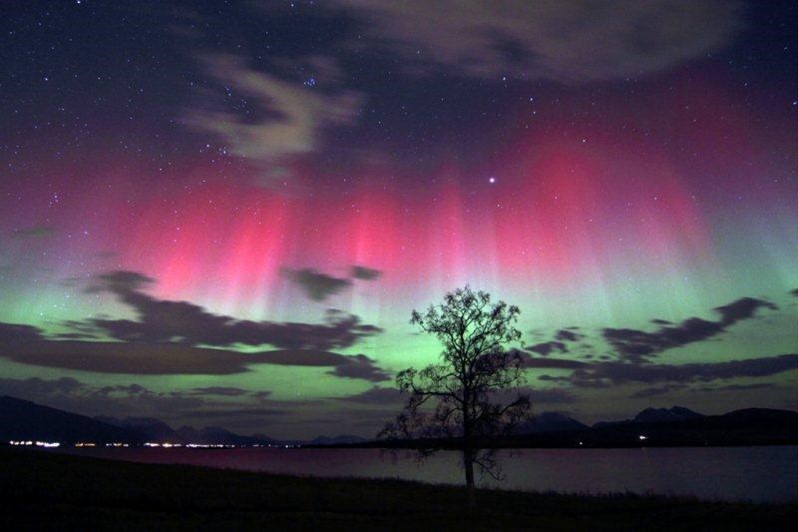
Aurora borealis, also known as the northern lights or polar light, in Tromsø, Norway, in December of 2011.
Credit: Arctic light - Frank Olsen, CC BY-SA 3.0, via Wikimedia Commons - In Finland, myths explain that arctic foxes create the aurora, running through the sky so fast that their fluffy tails ignite sparks as they brush against the mountains or create whirls of snowflakes that reflect the moonlight.
- In North America, some indigenous people believe the lights to be the spirits of departed ancestors, a way to communicate with lost loved ones or torches leading the spirits of those who have recently died across the abyss to a land of brightness. The Meshkwahkihaki (called the Fox Indians by European colonizers) have said that the lights are the spirits of slain enemies coming for revenge.
- Auroras that made it as far south as Europe tended to be red, driven by higher-energy solar storms that expanded these more intense auroras both toward the equator and higher in the atmosphere. Europeans saw red auroras as omens of war, even as recently as during the French Revolution.
- Auroras result when electrons and protons in the solar wind are deflected toward both polar regions, where they interact with atoms and molecules in Earth’s upper atmosphere.
- When the Sun is calm, the ever-present solar wind flows out of the Sun toward its planets at supersonic speeds of about 900,000 mph (400 km/s), taking 4 to 5 days to cross the 93 million mi (149 million km) distance to Earth.
- There are two sides to our Sun (ED-126). During solar storms, explosive coronal mass ejections (CMEs) eject plasma, while wide open coronal holes spew solar wind at as much as twice its normal speed (1.8 million mph, 800 km/s), resulting in chaotic disturbances to the normal geomagnetic balance between the Sun and Earth’s magnetic field.
- Earth’s protective magnetic field is distorted into a teardrop shape by the solar wind, deflecting most, but not all, of the incoming energetic particles.

Charged particles from the solar wind follow Earth’s magnetic field lines toward the north and south magnetic poles, where they dive into the upper atmosphere and create the aurora.
The solar system’s interplanetary magnetic field (IMF in the figure) may also influence the intensity of auroral activity, depending on its orientation.
Credit: NOAA SWPC
- Charged particles from the solar wind that are not deflected become trapped in Earth’s magnetic field and accelerate along magnetic field lines toward the polar regions.
- The particles strike the upper atmosphere in a donut-shaped pattern known as the auroral oval, centered on magnetic north between roughly 60° and 75° latitude, with a diameter of about 1,865 mi (3,000 km).
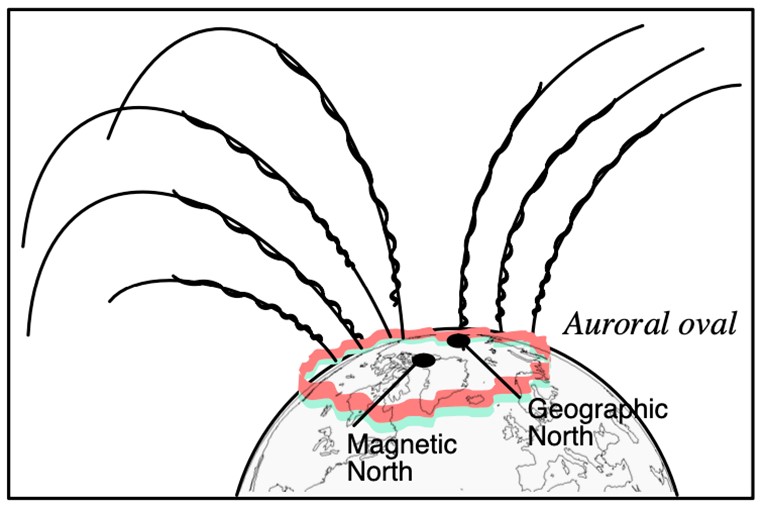
Energetic electrons spiral down the geomagnetic field lines toward the polar regions, striking the upper atmosphere, resulting in the display of auroral lights along the auroral oval.
Credit: NOAA - These electrons and protons ionize and excite the atoms and molecules in the thermosphere, 60 to 620 mi (100–1,000 km) above Earth’s surface.
- This excitation drives the particles to higher energy levels, and as they return to their normal states, they release their surplus energy as photons of light in various wavelengths.
- During periods of high solar activity, which can last for hours or days, the auroral oval expands toward the equator and to higher altitudes.
- The particles strike the upper atmosphere in a donut-shaped pattern known as the auroral oval, centered on magnetic north between roughly 60° and 75° latitude, with a diameter of about 1,865 mi (3,000 km).
- Auroras may appear green, pink, red, blue, purple and even yellow.
- The color produced depends on the altitude and, similar to neon lights, the gas composition.
- The rarefied gases in the thermosphere consist of oxygen (O), nitrogen (N), and helium (He).
- The photons released as particles excited by the solar wind return to their normal states give auroras their dancing colors.
- During a quiet Sun, oxygen atoms release photons at a wavelength of 557.7 nm, resulting in green auroras around 60 to 185 mi (100–300 km) altitude.
- The thermosphere is just dense enough that nearby reactions quench excitation reactions before they get to higher energy states.
- We can see green auroras best because green occurs at the center of the human visible spectrum.
- Sometimes, glancing sunlight will turn the tops of these auroral rays blue.
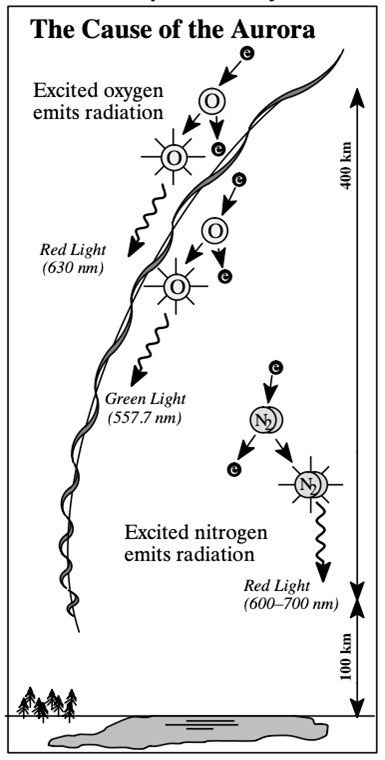
Energized particles from the solar wind that are not deflected by Earth’s magnetic field travel poleward along magnetic field lines, striking oxygen atoms and nitrogen molecules as they dive toward Earth’s surface. Energy from an atom or molecule excited by energized particles is released as different colors of light.
Credit: NOAA
- Nitrogen releases protons at wavelengths of 600 to 700 nm to produce red fringes at the base of the green curtains just above an altitude of 60 mi (100 km).
- When green and red light mix, the result may be pink or even yellow.
- It takes nitrogen less time than oxygen to emit these photons, so the pinkish accent often appears at the lower leading edge of the green curtains as they flow across the sky.
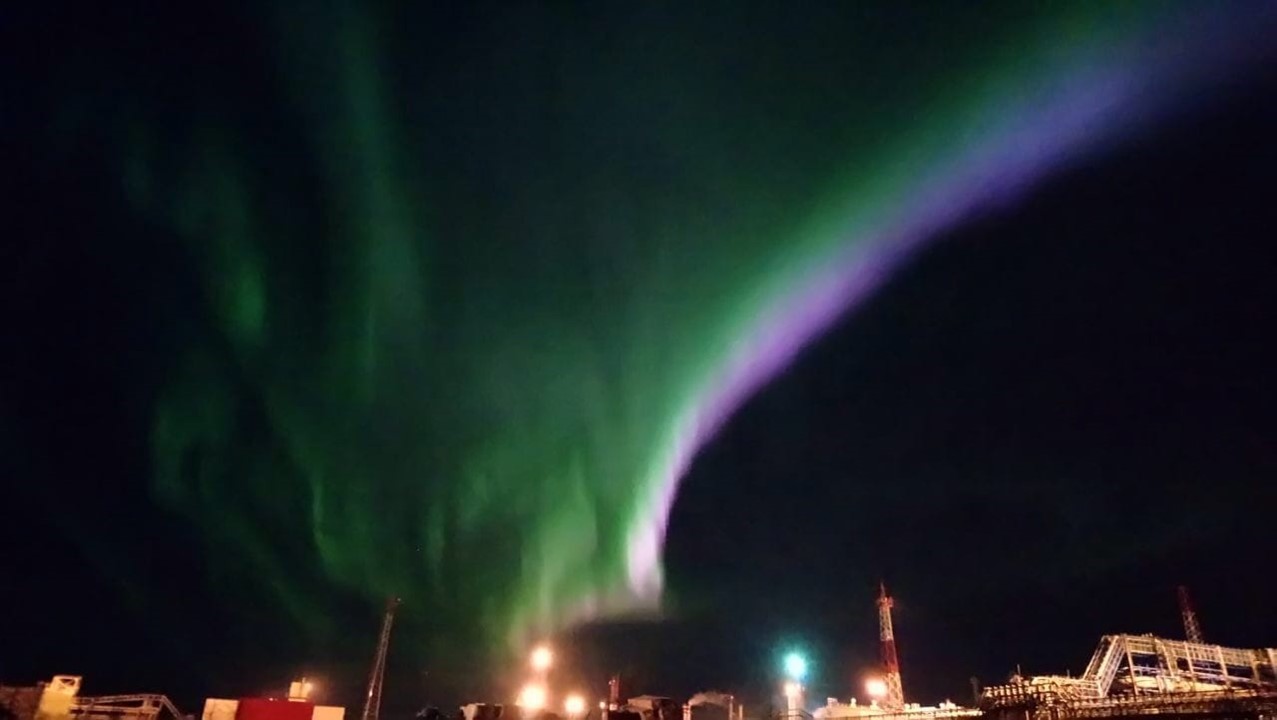
Northern lights sweep across polar skies with a leading edge of pinkish light from nitrogen molecule excitation followed by greenish light from slower oxygen atom excitation.
Credit: Chursaev13, CC BY 4.0, via Wikimedia Commons
- During solar storms, more-energetic solar winds inflate the thermosphere.
- This decreases particle density, reducing interference from nearby reactions, giving oxygen atoms enough time to release more-energetic photons at a wavelength of 630 nm, resulting in red auroras at higher altitudes of 185 to 380 mi (300–600 km).
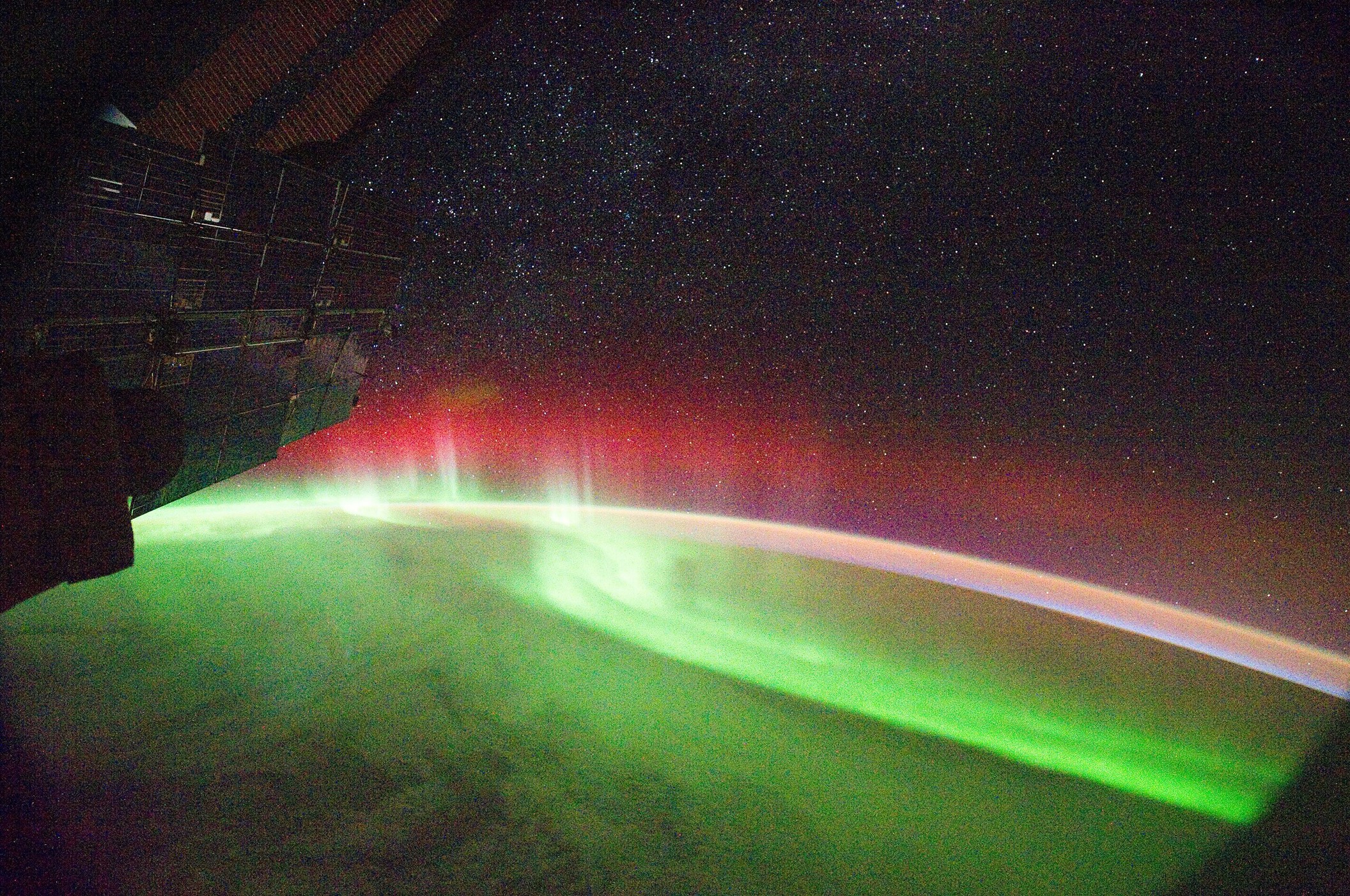
An image from the International Space Station shows a bright green and red aurora over our planet.
Credit: NASA - During very high intensity solar storms that occur about every 11 years during the solar maximum (ED-362 Solar Maximum is Heating Up), the entire inflated aurora may be red, extending as far south as Europe and the midwestern United States.
- This decreases particle density, reducing interference from nearby reactions, giving oxygen atoms enough time to release more-energetic photons at a wavelength of 630 nm, resulting in red auroras at higher altitudes of 185 to 380 mi (300–600 km).
- The thermosphere is on the edge of space, so it has a very low density of particles.
- But these particles do ebb and flow like celestial tides that interact with the dynamic magnetosphere to create the ethereal movement of auroras.
- The thermosphere can nearly double in size in response to solar storms.
- While auroras happen somewhere on Earth every day, you can optimize your aurora viewing by applying a few scientific concepts: the ground beneath the auroral oval is the best place to go to see the dazzling lights, and auroras are most active during solar maxima, semiannual equinoxes or around midnight each day.
- If the Sun is calm, the auroral oval occurs 15° to 30° toward the equator from the magnetic pole (not the geographic pole, see ED-122 Triple North Pole), however you can count on locations along Earth’s Arctic and Antarctic Circles (at about 66.3 degrees latitude) to provide good views.
- Since the actual geographic poles tend to be located inside the donut hole, auroral viewing is diminished there.

Different phases of the auroral oval over a typical night with moderate geomagnetic activity. The most active auroras occur near midnight because that region of the oval is farthest from the Sun.
Credit: NOAA - As solar activity increases during the 11-year solar cycle, the light display becomes more dynamic and colorful while the auroral oval inflates both vertically and laterally, making auroras visible over more of the globe.
- Auroras are most frequent around the time of the autumn and spring equinoxes. During equinoxes, Earth’s magnetic field is favorably aligned with the ecliptic (the plane of Earth’s orbit around the Sun), enhancing auroral activity.
- Beyond the equinoxes, winter is the best viewing season for auroras because the magnetic pole is tipped away from the Sun.
- Within a given day, the most active part of the auroral oval is the part farthest from the Sun, which you can see best around midnight.
- So, for the absolute best show, plan for a midnight viewing on a mountaintop along the Arctic Circle for the autumnal equinox, September 21 to 22, 2024, during the solar maximum of Solar Cycle 25.
- Auroras can also form as the solar wind impacts other planets and their satellites, especially those with atmospheres and strong magnetic fields.
- All the gas giants in our solar system have robust magnetic fields that support auroras, but the largest planet, Jupiter, with a magnetosphere 20,000 times stronger than Earth’s, has the most stunning aurora, fueled in part by particles from its volcanic moon Io.
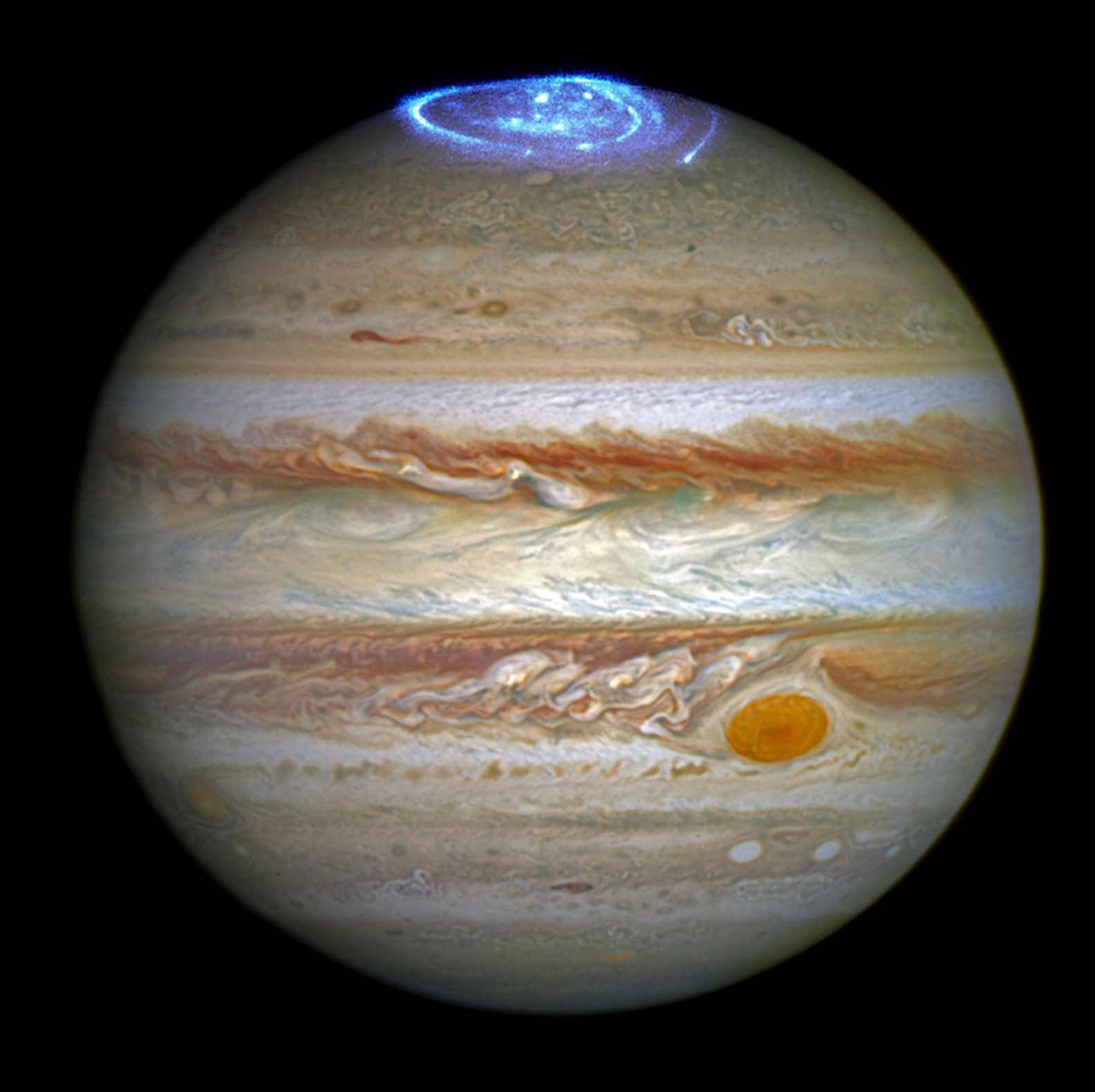
Jupiter’s magnificent ultraviolet aurora was photographed by NASA’s Hubble Space Telescope Imaging Spectrograph as NASA's Juno spacecraft approached and entered into orbit around Jupiter. This image superimposes the aurora on a full-color image of Jupiter separately photographed by Hubble's Outer Planet Atmospheres Legacy (OPAL) program.
Credit: NASA, ESA, and J. Nichols (University of Leicester), public domain, via Wikimedia Commons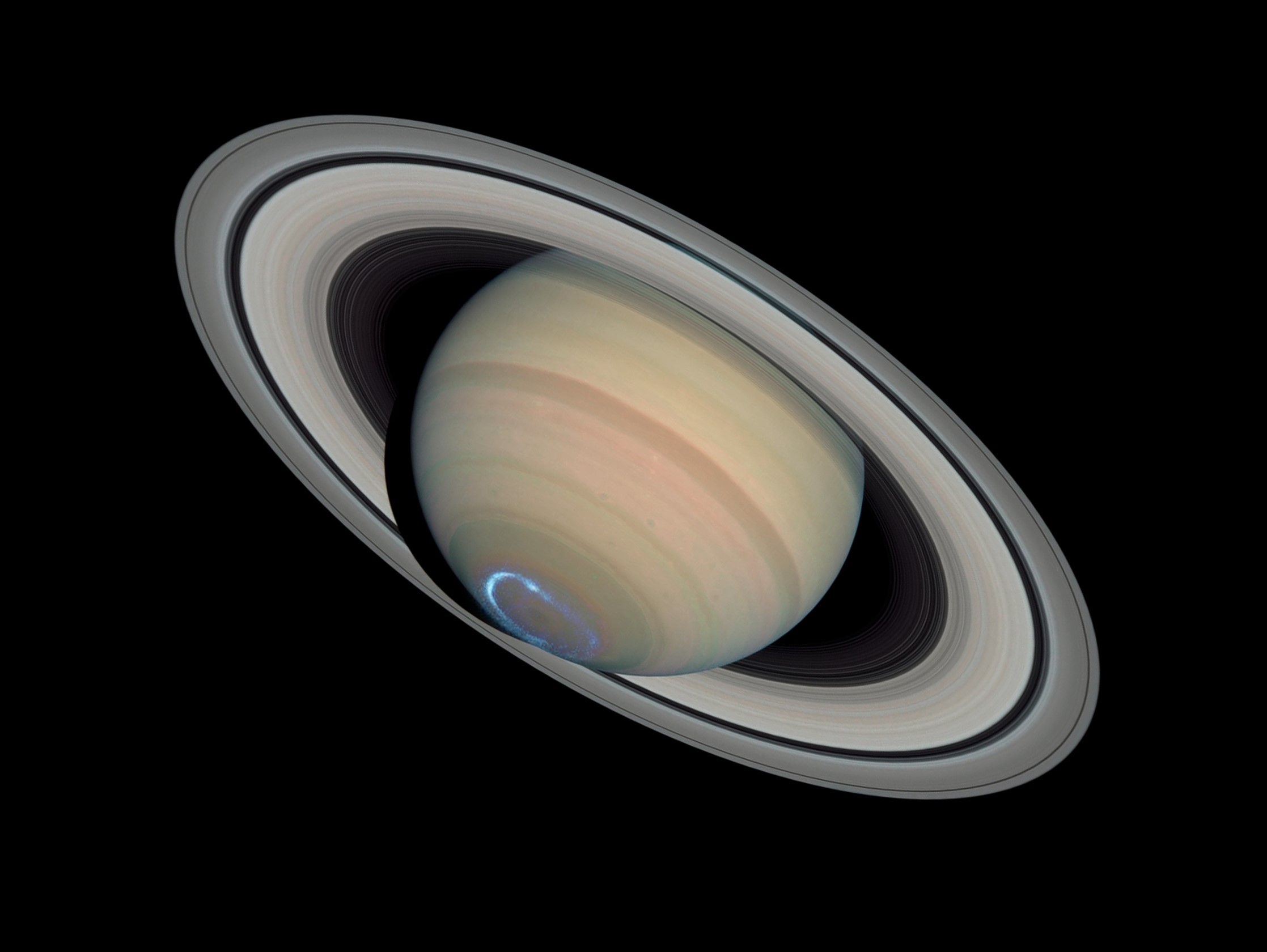
Photomontage of Saturn with a false-color image of ultraviolet aurora taken with NASA’s Hubble Space Telescope Imaging Spectrograph superimposed on a visible-light image from Hubble’s Advanced Camera for Surveys.
Credit: NASA, ESA, J. Clarke (Boston University), and Z. Levay (STScI), public domain, via Wikimedia Commons - Even Mars and Venus, with their weak atmospheres, can display dim auroras during intense solar activity, possibly produced from the Sun’s own magnetic field or from ancient artifacts of their now-defunct magnetic fields.
- All the gas giants in our solar system have robust magnetic fields that support auroras, but the largest planet, Jupiter, with a magnetosphere 20,000 times stronger than Earth’s, has the most stunning aurora, fueled in part by particles from its volcanic moon Io.

